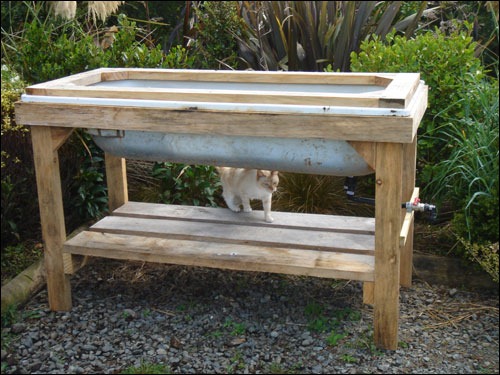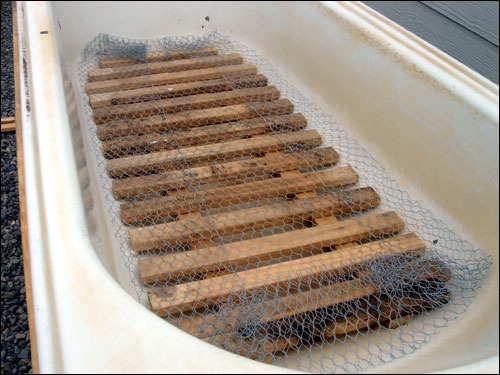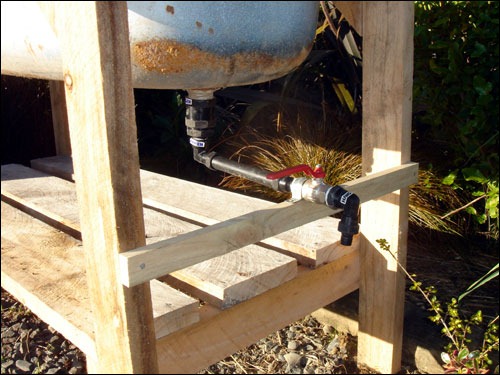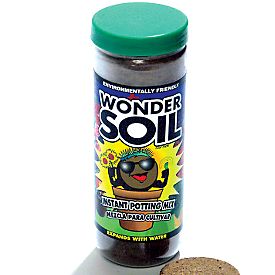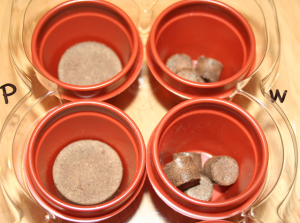Make a worm bin out of a bath tub
15.3 years ago vermicomposting, worms
Over at LifeBoat Farm they have created this great DIY Worm Farm out of an old bathtub. What I like about this build is they could have easily taken the bathtub propped it up on some cinder blocks and have been done with it. They took the extra effort with the wood enclosure (with bonus storage shelf) and proper drainage making use of the actual drain it almost appears that this is the true use for this bath tub.
Tags: worms
Using WonderSoil for seed starting
15.3 years ago cucumbers, fertilizer, indoor seed starting, vermicomposting, wondersoil
I had great results using coconut coir last growing season it was great to work with, retained water great for young seedlings, and was economically priced. The only challenge was actually finding some to use this year. No luck in local stores, last year I only could find a single block in one hardware store. Online there are plenty of locations that sell them, but unless you have a need for a couple metric tons, the cost of shipping can be more than the the product itself.
Finally, I found a solution to my problem WonderSoil Their main product line consists primarily of the same core component but they sell it in many different convenient sizes for various uses. One great feature of the product is it expands up to 12 times its original size. For someone like myself that does not have the space to store bags of peat/potting mix around my already full garage this is a great feature. You can check out all of their products but the ones that felt matched my growing needs were the following:
- Shake, Water, and Plant — 1/2 inch mini wafers that can be added to any of your pots. In my case I underestimated the expansion of these little things and made a little mess and it overflowed on my table (apparently 3 was the magic number not 4)
- The Tube — There are larger wafers made specifically for 4 inch pots, in my case this would be newspaper pots
- Reground Wafers — This is basically a loose version available in 2 or 5 lb bags. This is a more economical option which I will plan on using when doing larger seed trays.
For Christmas I got indoor seed starting kit which came with pots/seeds/peat pellets. I decided this would be a great opportunity to do a little side by side comparison. From the start I was WonderSoil seemed like the obvious winner. After adding a little water, it fully expanded in just a few seconds and was fluffy and ready for me to drop a seed in, the peat was a swampy mess.
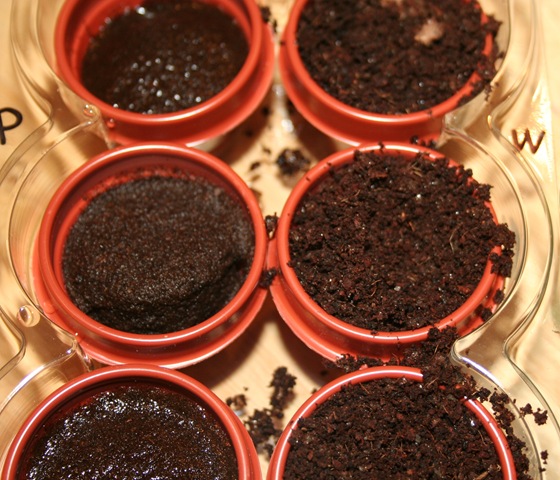
Peat pellets Left, WonderSoil Right
After a few minutes and fluffing with a fork the peat was ready to planting. I put cucumber seeds in both peat and WonderSoil pots and I will provide some updates on how things progress on my little experiment.
After the WonderSoil had some time to settle in my cheap LED grow box I did see some strange formations appear in the soil.
I little concerned I went back to their product and I believe this is their “water saving polymers” in action which I would assume is some sort of gel crystal which is supposed to save up to 50% water. They also boast about use of worm castings which I am definitely a fan of as well as addition of a balance of various micronutrients.
I will have to wait and see if the product produces as well as it claims, but I must say I am definitely impressed at this point and have high hopes for WonderSoil for this years seedlings.
UPDATES:
Christmas light LED grow box – Update #1 (WonderSoil)
Tags: cheap, compost, garden seeds, growbox, led, outdoor plants, vegetables, worms
Make your Garden/Lawn into a gigantic worm bin
16 years ago alfalfa pellets, vermicomposting, worms
My soil is consisted of a high percentage of clay, as a result I am required to aerate my lawn twice a year to avoid my soil getting too compacted. I am cheap so I purchased a $10 aerator from Home Depot which I walk around the lawn giving it a nice look of a goose bathroom until the next good rain or mowing. Of course nature has an answer which is the garden earthworm. As a finished limping behind my aerator I thought how can I get more earthworms to do some of this work for me, which brought me to the conclusion to turn my lawn and garden to a gigantic worm bin.
As worms wiggle through the ground they break up the soil and provide pathways for water and air to flow and while they are at it drop their nutrient castings along their way. Now looking at my tips on how to care for a worm bin, the same principles apply to doing the same on a larger scale. Our course my wife and HOA would appreciate me just throwing our kitchen waste out in our front yard so I have to be a little more creative. For organic matter to feed the worms (and the lawn) I will be using alfalfa pellets and grass clippings (mulch) As for moisture, given I live in the Seattle, WA area our frequent rains take care of this until mid summer where short frequent watering will keep the grass and the worms happy. I will avoid chemical fertilizers, herbicides, and pesticides using organic options to control weeds and pests and occasional application of alfalfa pellets to fertilize the lawn.
At this time the results look good the lawn looks great and I have definitely seen an increased number of worms in my garden and yard. The birds have also noticed and are taking advantage of my increased population and taking care of some of the excess in my lawn (guess it is better than them eating my seeds planted in the garden)
Just as a warning like everything in life too much of anything is normally not a good idea which can apply to worms as well. Worms can move enough soil and leave piles of castings on the surface which can create a lumpy lawn, which as long as you don’t have a putting green for a lawn this will probably not be unsightly and on the next rain will give some extra nutrients to your soil/lawn. Given the current state of my soil I have quite a while until I am burdened with having too loamy soil and need to be concerned on how to drive the worms away.
Tags: alfalfa pellets, birds, cheap, compost, garden seeds, organic vegetables, outdoor plants, vegetables, worms
Vermicomposting – How to harvest your worm poop (castings)
16.1 years ago harvest, vermicomposting, worms
Now your worms have been working hard eating, pooping, and reproducing so now it is time to harvest the fruits of their labor (worm castings) There are a few methods to harvest worm castings so I will briefly describe a few:
Dump and Sort Much like it sounds you simply dump out your worms and castings onto a plastic sheet. Sort through and catch as many worms as you can and set them aside.
Divide and Harvest Move you compost and worms to one side of your worm bin and fill the other half with new bedding. For the next couple weeks only bury food on the side with the fresh bedding. During these two weeks a majority of the worms will move over to the other side where you can harvest the castings minus the worms.
Moving on Up Create a second bin which you place on top of your existing one (Rubbermaid containers and 5 gallon bucket worm bins work great for this) and fill it with clean bedding and food and after a couple weeks the worms will migrate into to the new bin. Now you simply harvest the lower bin.
Using any of these methods I would suggest using a soil sieve like I showed how to create previously to better separate food/bedding from the castings and either use the remains in your next bin or put them right into your compost bin.
Tags: cheap, compost, vegetables, worms
Vermicomposting – How to take care of your worms
16.1 years ago vermicomposting, worms
Your worms need 6 things to stay healthy: temperature, food, moisture, airflow, bedding, and darkness.
Temperature: Your worms need to be stored between 55 and 77 degree. During the hot days of summer you should keep your worm bin in the shade and during winter you should keep it indoors or in your garage.
Food: Worms are vegetarians so any garden waste you normally would add to your compost (expired fruits and vegetables, bread, egg shells, cereal, etc) you can give to your worms. There are some tricks to make the fruits/vegetables easier for the worms to eat by putting the food in your freezer for a few days and/or putting it in a blender and make a worm food smoothie.
Moisture: Lack of moisture is the easiest way to kill off your worm population. Like us worms contain a high percentage of water without moisture they will dry out and die. Most of the time the food you add will give your worms enough moisture to be happy but on hot/dry summer days you might need to add a little extra water to your bin.
Airflow: Worms need air to live, make sure your worm bin has air holes. You must also ensure that your bin does not get too soggy which can suffocate your worms. If you find your bin begins to get too wet add some shredded paper and mix in with the existing bedding. If you bin frequently gets waterlogged you may want to add some extra air holes to your bin.
Bedding: Bedding gives worms space to live and also allows area to bury food scraps. This also adds material to store some extra moisture.
Darkness: As long as your bin is created out of a opaque material and you keep a lid on it this one should take care of itself.
Tags: compost, vegetables, worms
Vermicomposting – How get your worm bin ready
16.1 years ago vermicomposting, worms
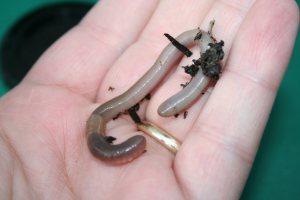
Now you have created your own worm bin now you need to get it ready for your worms. The worms need some bedding, which you can buy some coir worm bedding online or you can make some yourself by taking confidential documents from your shredder and soaking in water until it has the consistency of a wrung out sponge. Now not only shredding your documents but having worms eat them and then spreading their castings in your garden, talk about organic security. Simply add this wet paper with a handful of compost for grit (worm fiber) to your worm bin and you are ready for the worms.
The best worms you can get for vermicomposting are red wriggler (Eisenia Fetida) because they digest nearly their weight per day, creating lots of precious castings. They also enjoy eating close to the surface so they will happily eat food you place at or just under the surface. You can purchase these red wiggler worms online or at your local worm farm. I could not get myself to pay $20 for worms, so I went the cheap route and with my daughters took some worms from our garden. They do not have as big an appetite, if I get a population more than my bin can support (yes they multiply quickly) I can simply add them to my garden without worries of effecting the native worm ecosystem.
Now you should have a happy worm habitat which can provide rich nutrients to your garden.
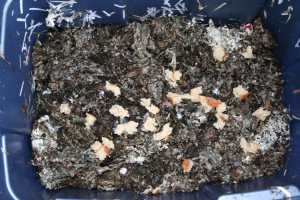
Tags: cheap, compost, organic vegetables, vegetables, worms
